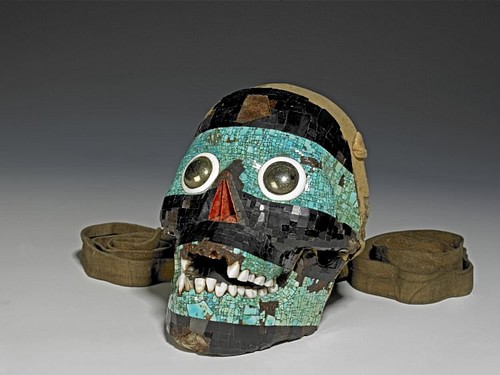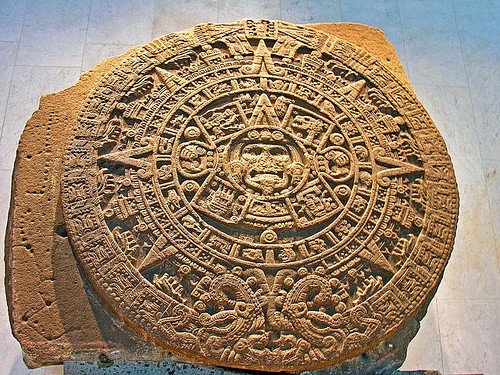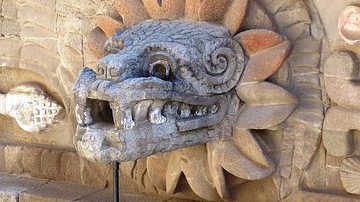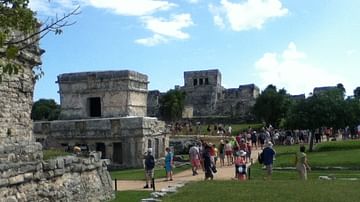
Tezcatlipoca (pron. Tez-ca-tli-po-ca) or 'Smoking Mirror' in Nahuatl was one of the most important gods in Postclassical Mesoamerican culture and particularly important for the Toltecs and the Aztecs, especially at Texcoco. He was an invisible and omnipotent creator god, patron deity of warriors, and, as the bringer of both good and evil, he was the very embodiment of change through conflict.
Often considered the supreme god of the Aztec pantheon, he took on a bewildering array of names and manifestations depending on where and by whom he was worshipped. Tezcatlipoca was the 10th of the 13 Lords of the Day and associated with the horned owl in the Mesoamerican calendar whilst his nagual or animal spirit was the jaguar. For the Mexica he was associated with day 1: Death and the god was especially worshipped during Tóxcatl, the 6th month of the 18-month solar year with those who did revere the god carrying the epithet titlacauan, meaning 'we are his slaves', indicative perhaps that, for good or bad, there was no escaping the attentions and influence of Tezcatlipoca.
A Creator God
The Mesoamerican deity Tezcatlipoca was believed to be the son of the primordial androgynous god Ometeotl. In Aztec mythology he was the brother of Quetzalcoatl, Huizilopochtli and Xipe Totec. In the complex Mesoamerican and Aztec creation myth, Tezcatlipoca ruled the first world of the Sun but was then overthrown by Quetzalcóatl. The two later cooperated, however, to create the 5th Sun. Transformed into giant snakes, the two gods attacked and dismembered the female reptilian monster known as Tlaltecuhtli (or Cipactli), one part became the earth and the other the sky. Trees, plants and flowers sprang from the dead creature's hair and skin whilst springs and caves were made from her eyes and nose and the valleys and mountains came from her mouth.
The Many Faces of Tezcatlipoca
Sharing traits with the earlier God II of the Classic Maya, Tezcatlipoca was often regarded as the one supreme omnipotent god in various Mesoamerican cultures and all other gods could be considered as manifestations of this one great being. He was known as Black Tezcatlipoca or the 'Smoking Mirror', god of the day and of Texcoco. The mirror may signify that the god is all-seeing or that he rules over all of the earth, sometimes referred to as a smoking mirror. He is also known as Blue Tezcatlipoca, the 'Hummingbird Sorcerer', god of Tenochtitlán, where he was associated with the sun and the war god Huitzilopochtli. He could be known as Red Tezcatlipoca, the 'Flayed One' and associated with the gods Camaxtli and Xipe Totec (god of the Tlaxcaltecans) or as White Tezcatlipoca, the 'Plumed Serpent' or Quetzalcóatl, god of the Cholula. Yet another manifestation of the god was as Tepeyolohtli, the jaguar god that lived in the centre of the mountain of the earth.
Ever-present, the god could intervene directly in human affairs to bring both happiness and sorrow. Tezcatlipoca could take on more sinister connotations when he was known as lord of the shadows or night, a sorcerer of black magic and the bringer of evil, death and destruction as Chalchiuhtecólotl, 'Precious Owl' or Chalchiuhtotolin, 'Precious Turkey'. Also associated with conflict he was known as Yaotl or 'Enemy' and was patron of warriors and their training camps (telpochcalli). He was not always protective to soldiers, though, for sometimes he could be found at crossroads at the dead of night, ready to challenge any unsuspecting warriors.
In a similar vein, Tezcatlipoca could represent those other disagreeable elements of the human condition: intense cold, sin and misery when he took on the guise of Itztlacoliuhqui. Finally, in a more positive role, when he was Omácatl, he was seen as the patron of the aristocracy and feasts. In keeping with the god's complex character of conflicting opposites, though, in this role he could at the same time represent thieves and evil sorcerers.
Tóxcatl Ceremonies
In the month of Tóxcatl, the sixth month (or 5th) of the Aztec solar year, Tezcatlipoca was worshipped in special ceremonies. As with other Aztec religious rites an important part of the ceremony was the impersonation of the god, most often by a prisoner of war, typically the best looking and most courageous one. For one year before, in fact, the captive was tutored by priests, treated as a noble and even given four women to look after him. These women themselves impersonated four goddesses - Atlatonan, Huixtocihuatl, Xilonen and Xochiquetzal. When the special month finally came around the impersonator was handsomely dressed in a warrior costume and in a symbolic wedding festival he married his four goddesses. Honoured with flowers and dances the man-god was then ferried to a dedicated temple where he was promptly sacrificed and his heart removed using an obsidian knife in order to honour the real Tezcatlipoca.
Mythical Adventures
Besides the Creation, Tezcatlipoca is involved in many mythical tales and one of the more curious is the arrival of the first dogs. The trouble began with the old couple Tata and Nene, survivors from the flood which had previously destroyed the 4th world. Finally making land they beached their cypress log boat and proceeded to make a fire by rubbing sticks together. Then they decided to cook a fish but the smoke from their fire disturbed the stars, especially Citlallatonac and Citlalicue. These gods complained vociferously to Tezcatlipoca who, perhaps a little harshly, lopped off the heads of the couple and reattached them to their backsides, thus, the very first dogs were created.
Another story from Aztec mythology explains Tezcatlipoca's association with music. One day the god instructed a black wind god to go to the sun and fetch some music. The wind god needed help for such a dangerous mission and so he enrolled Tezcatlipoca's assistants - a turtle, mermaid and a whale - these he put together to make a bridge so that he might cross the ocean. The sun saw the wind god arriving and warned his entourage of musicians not to answer any demands the wind might make, otherwise, they would be sent back to earth with the wind. However, the wind god started singing in such an irresistible manner that one of the musicians felt compelled to answer and so he was punished by the sun and made to return to earth, bringing with him the gift of music. The god's love of music was also displayed during the ceremony in Tóxcatl where the Tezcatlipoca impersonator broke a flute every step of the pyramid he climbed on his way to being sacrificed.
Representations in Art
The earliest certain representations of the god in art appear in the stone sculpture of the Chichen Itzá in the Early Postclassical period (900-1200 CE). Here he may have a smoking mirror on his head and a serpent in place of a foot, whilst in later depictions of the god he has a polished black obsidian mirror instead of a left foot. This replacement of the foot is a reference to a wound he received in his famous battle with Tlaltecuhtli during the Creation. He is often in the company of a turquoise snake, may have painted on his face yellow and black stripes and wear a costume with corn designs (in reference to his role as god of the dry season and war) and skulls and bones (as he is an underworld god). Sometimes he carries four arrows in his right hand, weapons he uses to punish wrongdoers. The god could be depicted in different colours depending on which cardinal point he was representing - black for north, blue for south, red for east and white for west.
Tezcatlipoca is often represented wearing a turquoise mask with a black eye band. Indeed, one of the most famous art objects of the god is the decorated skull now in the British Museum in London. The skull is covered in turquoise and black lignite mosaic with red thorny oyster shell in the nasal cavity. Polished pyrite surrounded by white conch shell provide the eyes. The mask interior is lined with deerskin and the same material is used for the two straps attached to the skull. This striking object may well be one of the gifts that the Aztec king Montezuma II gave to Hernando Cortés in 1519 CE.







